Buying a ski goggle is not that easy... When you're facing the hundreds of models available in store, they do look very similar at first glance and making a choice is everything but easy. So, how to proceed? How to make the right choice? What are the differences between all those goggles? Here’s a complete guide to help you narrow it down and refine your selection down to the models that will suit your needs.
- What's the point of wearing a ski goggle?
- What are the elements of a ski goggle?
- What is a goggle lens made of?
- What lens shape for your goggles?
- OTG goggles, designed for wearing over prescription glasses.
- Which class for your ski goggle?
- What are the benefits of a photochromic ski goggle?
- What colour for your goggle lens?
- What are polarized goggles?
- What are the newest and best lens technologies?
- How to make your goggles more comfortable?

What's the point of wearing a ski goggle?
Wearing goggles when skiing is not just a matter of style but also and above all a safety issue. On the slopes, your eyes are at risk all the time and only a goggleq can protect them fully
.
Risk 1: UV rays, ambient light
This is the main role of a ski goggle: protect you from the sun, from its UV rays and from risks related to high brightness due to the light reflection on the snow. UV rays are way more aggressive in altitude, they can damage the conjunctiva and the cornea of your eyes. The intensity of those rays increases by 10 to 12% every 1,000m (3,200ft). Therefore, the higher you ski, ride, climb or hike, the thinner the atmosphere gets and the less it filters those harmful rays. Moreover, snow reflects 85% of UV radiation even when the sky is cloudy and the time when light is at its strongest is between 10am and 2pm.
In the worst case scenario, an exposure to UVs without protection can cause a photokeratitis also known as snow blindness. It is an intense exposure to UV light of the membranes that protect your eyes, which leads to the death of the external cells of your eye bulb. The pain comes from your eye trying to eliminate those dead cells. However, it's not usually noticed straight away and the first symptoms may show up several hours later. Speaking about symptoms, here is what you may feel or see: red eye, tears, feeling like there is sand in your eye, temporary blindness... You'll heal naturally but it will take up to 48 hours.
In the worst case scenario, an exposure to UVs without protection can cause a photokeratitis also known as snow blindness. It is an intense exposure to UV light of the membranes that protect your eyes, which leads to the death of the external cells of your eye bulb. The pain comes from your eye trying to eliminate those dead cells. However, it's not usually noticed straight away and the first symptoms may show up several hours later. Speaking about symptoms, here is what you may feel or see: red eye, tears, feeling like there is sand in your eye, temporary blindness... You'll heal naturally but it will take up to 48 hours.
Add to this the ambient light which can cause glare, eye fatigue leading to headaches and visual discomfort. This is why it is important to wear a ski goggle that's adapted to the light conditions.
Risk 2: terrain changes
Sun reverberation on the snow or fog can alter your perception of the terrain and lead to a fall in case of a sudden bump or unexpected icy patches. A good snow goggle will help you see those better, especially goggles featuring a lens that was specifically designed for those conditions (read further).
Risk 3: cold, snow, rain
Another great benefit of a snow goggle is, it protects you from the cold. When you're riding full speed on the slopes, negative temperatures and side wind can be annoying. Your eyes start crying and your vision gets blurred. And when it rains or snows it gets even worse. Luckily, snow goggles prevent all that. It is the accessory you need if you want to keep the elements away from your eyes.
Risk 4: intrusion of a foreign body
To end this list, remember that a snow goggle works like a shield against foreign bodies that could injure your eyes. From the small rock to the tree branch or pole tip, there are hundreds of opportunities to hurt yourself on the mountain. Wear a snow goggle and reduce those risks!
The different parts of a ski goggle:
A snow goggle is made of:
- a lens that ensures the protection of your eyes
- a frame, also called chassis, which supports and connects every other element
- a face foam, it delivers comfort and fit
- a venting system to ensure airflow and avoid fogging
- a strap that holds the goggle on your head or helmet
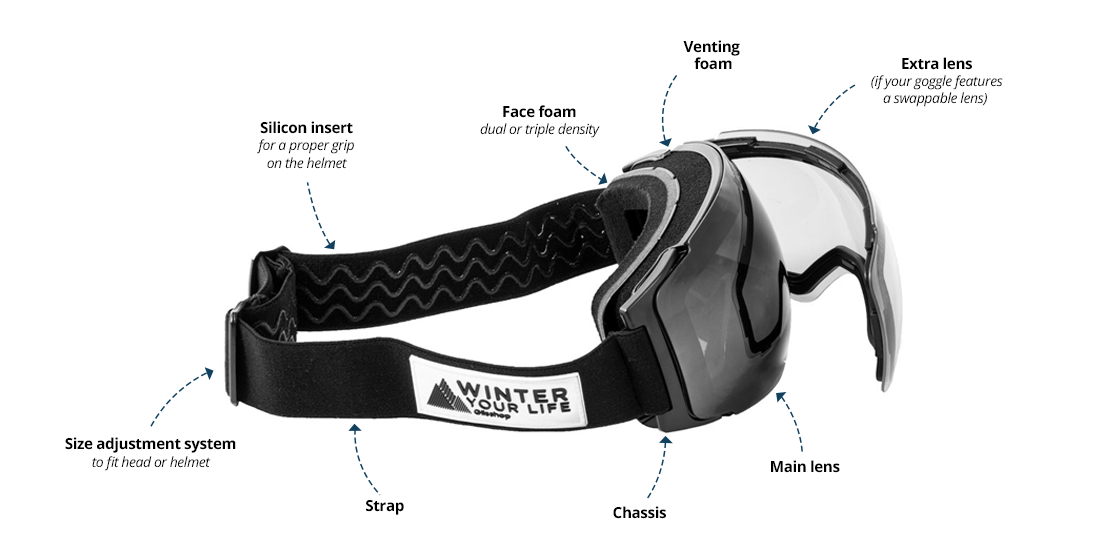
Organic or mineral glass, what materials are used in lenses?
Mineral glass:
Historically, goggle lenses were made of mineral glass. On top of its outstanding optics performance (including a low chromatic dispersion), natural (or mineral) glass is also extremely resistant to scratches. On the downside, this type of glass is a lot more fragile and heavier than organic glass.
Organic or polycarbonate glass:
Organic glass is slowly replacing mineral glass in ski goggles If it is more subject to scratches, it is way stronger. Nowadays, snow goggles are mainly made of Polycarbonate (PC), a synthetic plastic material with high shock resilience. Unlike mineral or natural glass, it is almost unbreakable. It's also very light and very comfortable and comes in variety of shades and colours.
NXT Glass:
This is the latest generation of glass and it combines the best properties of both mineral and polycarbonate glasses without their flaws. Unlike polycarbonate, which is injected at high temperatures, the NXT glass is molded at low temp. Made with Trivex, it delivers a crystal-clear visibility that's very similar to mineral glass. NXT is also unbreakable. It was tested in windshields of helicopters. It's also ultra-light as it weighs 14% less than polycarbonate.
Spherical or cylindrical, what’s the difference?
There are two main types of lenses, spherical or cylindrical. Even though it comes to a question of style most of the time, each has its own advantages and drawbacks.
Cylindrical lens:
Curved on a 2 dimension plan to follow the curves of your face.
Cons: the field of view is slightly smaller.
Pros: less optical distortion for a clearer vision, a more affordable price and a vintage look!
Pros: less optical distortion for a clearer vision, a more affordable price and a vintage look!
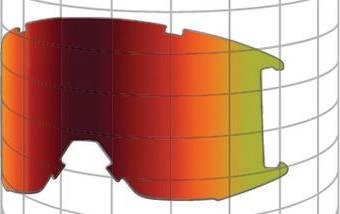
Cylindrical lens
Spherical lens:
Spherical lenses are curved in 3 dimensions to adapt to the shape of your retina.
Cons: due to the curved shape, the vision might be slightly altered on the sides. It can also create a prismatic effect that diverts light rays, a rare occurrence that can lead to a delayed perception of the image and therefore to visual fatigue. The phenomenon generally strikes people who wear progressive glasses. Its manufacturing process also makes it a bit more expensive.
Pros: your field of vision is way wider which is ideal for freeriding. And you get a nice modern look as a bonus.
Pros: your field of vision is way wider which is ideal for freeriding. And you get a nice modern look as a bonus.
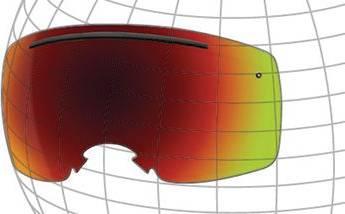
Spherical lens
OTG goggles, keep your glasses on!
Not everybody can afford ski goggles suited his view. The OTG models (for Over The Glasses) allow glasses to be worn inside the goggles thanks a greater volume and a specific foam cut at temple level. If you can't stand contacts, this type of goggles is a safe pick.
Oakley, Julbo, and Salomon all offer high-end OTG models. Cairn, Cébé or Bliz goggles are more affordable and Atomic and Scott certainly have the best value-for-money.
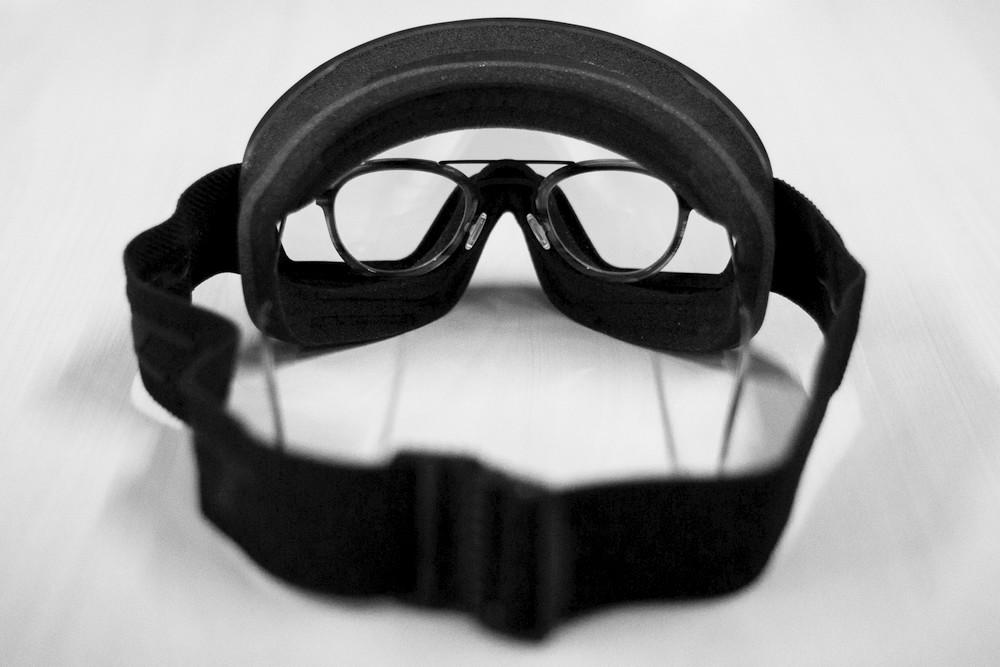
Goggles suited to be worn over prescription glasses
What protection level should you go for?
All ski goggles are certified by the EN174 standard that guarantees a 100% protection against UV. It’s the visible light transmission or VLT that varies between models depending on the glass category (or class) you choose.
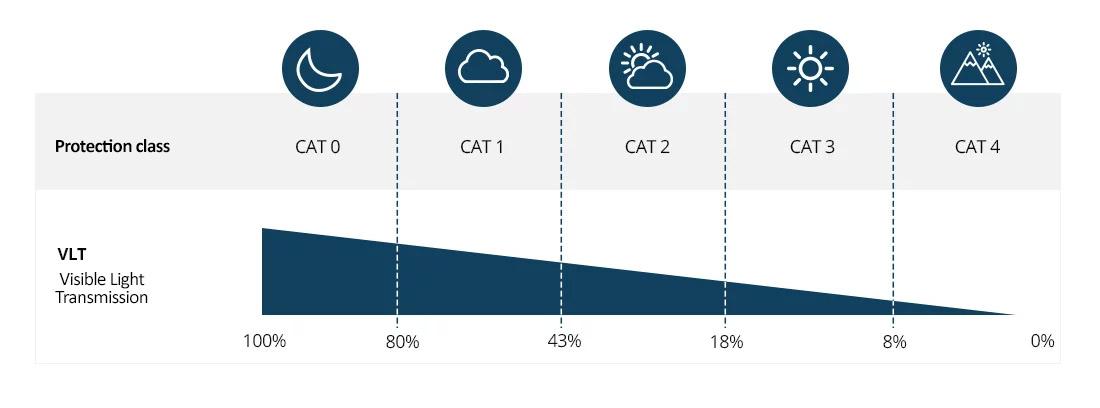

Class 0 lenses
These lenses let about 80% of the light go through. These are non-tinted lenses made for your night-time outings. Check the lenses from Bliz if that’s what you’re looking for.

Class 1 lenses
These lenses allow between 80% and 43% of visible light to go through. These are lightly-tinted lenses with a clear shade that will be ideal for white days, foggy conditions, and low light.

Class 2 lenses
These lenses allow between 43% and 18% of visible light to go through. With an intermediate tint, these are fairly versatile lenses that work wonders in cloudy weather.

Class 3 lenses
These lenses only let through between 18% and 8% of visible light. They are most commonly used with a dark shade and suitable for sunny days.

Class 4 lenses
This type of lenses allows less than 8% of the light to get through. Pretty rare, they are used at high altitudes, on glaciers for example, or in extreme conditions.
What’s a photochromic lens?
You get it, you need a lens suited to the conditions you’re about to face but how to make sure you always get the right one at the right time? Do you need to buy several goggles and bring a spare lens with you?
That’s indeed a possibility but if your budget allows it, the photochromic lens is still the best solution.
Super convenient, these lenses react to UVs and adapt automatically to the ambient light. To put it simply, they darken when it’s sunny and lighten up when it gets darker. They can cover two and up to three protection classes.

Julbo photochromic lens technology

Discover how a photochromic lens works
Yet, there are a few downsides. First, it's not immediate. We’re not talking about a few seconds but rather a few minutes depending on the models so do not expect an instant change when you’re going through the woods for example. Then, the thermo-dependency, some entry-level photochromic models tend to have trouble working when the temperatures drop too low. To prevent these kinds of issues, you should opt for the latest-generation NXT lenses.
They might be versatile but photochromic lenses do perform slightly less than high-end mono-category lenses.
And just in case, there’s still another alternative, ski goggles with interchangeable lenses!
And just in case, there’s still another alternative, ski goggles with interchangeable lenses!
What tint should you go for?
In addition to these categories or classes, you also get different lens tints that enhance your perception of the terrain, maximise contrasts or optimise colours.
Yellow, pink, and orange highlight terrain changes, especially when it’s foggy. However with a yellow lens on, you will get blinded more easily if the sun shows up all of a sudden, pink and orange are more versatile.
On the opposite, grey and brown are more effective in bright conditions. Grey is neutral, it's the shade that least distorts colours. Brown is the most soothing and the most comfortable tint. Mirrored lenses prevent glare by reflecting sun rays.
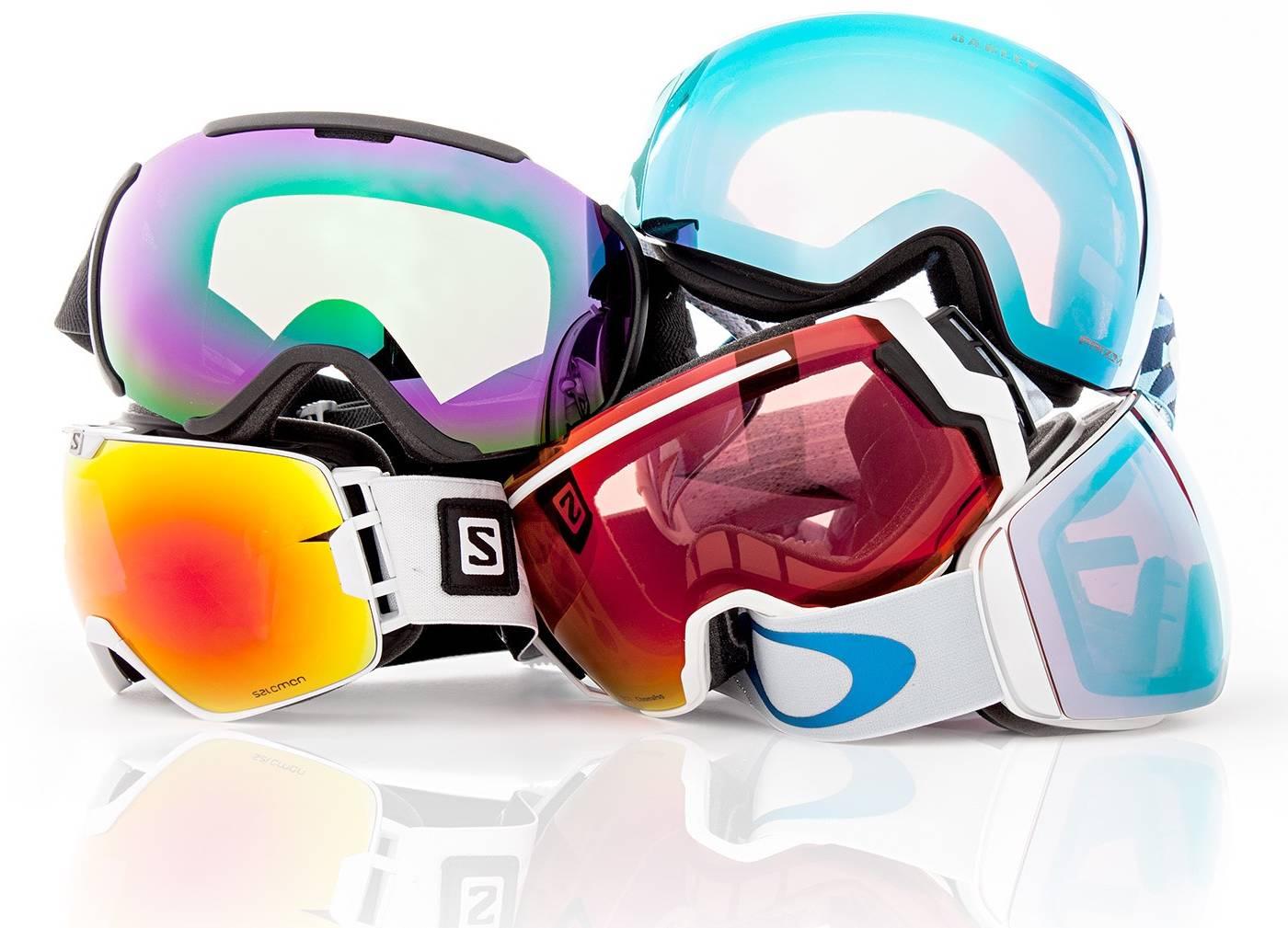
How about polarized lenses?
Glare comes from polarized light. This indirect light comes from the sun’s reflection on reflective surfaces such as water or snow. Polarized lenses block the dazzling rays while allowing the light that carries information to pass through, a bit like a Venetian blind if you will. They enhance contrasts and colours which makes them great for sunny conditions and offer more comfort along with improved visual acuity. However, if polarization prevents glare, it might also prevents you from seeing icy patches due to the dampened reflections.
In order to avoid this, Julbo developed the Glare Control technology. A partial polarization that suppresses the glare effect from the snow while keeping ice bright and shiny. These low-polarized lenses are more effective when they are photochromic too.
What are the new lens technologies?
Eager for comfort and performance, brands are always looking for new ways to improve their products and find new technologic wonders. From the simple gadget to the revolutions that redefine the market, here’s what they’ve got to offer.
Goggles with interchangeable lenses
As we said earlier, ski goggles with interchangeable lenses are a good alternative if you don’t want to (or can't) buy two different goggles or a photochromic one. Different options are available depending on the brands: levers, pivots, clippers or magnets, the choice is yours!

Swap your lens in seconds with magnetic frames!
Frameless goggles are commonly featured in this category since the absence of frame makes it easier to swap lenses on the spot.
Magnetic lenses are without a doubt the most convenient, especially when you want to swap lenses at the top of the mountain by -10°C with your gloves on!
Vivid technology from Giro
Giro is another brand to bet on Zeiss Optics expertise to design its Vivid technology. The idea was to offer the best visual experience by enhancing contrast and clarity which leads to a faster perception and less eye fatigue. Most sunglasses filter blue light even though this light is absolutely necessary to views shadows, bumps and terrain changes. The Vivid technology manipulates this blue light to enhance contrasts all while filtering harmful rays, thus providing you a greater visual acuity and optimal hues no matter the weather.

View how Giro Vivid tech works
Clarity technology by POC
POC thinks that snow and ice reflections are actually needed to anticipate terrain changes. The brand wanted to get rid of polarization and maximise clarity. That’s how they came up with the Clarity technology jointly designed with Zeiss (a leader of the optical industry). These lenses filter specific parts of the light spectrum that increase or diminish certain colours’ frequency. POC came up with two collections including one for racing, each with 4 different shades (with a VLT that goes from 13 to 49%) for a perfect view. Finally, the Spektris mirror coating protects your eyes from glare and reduces eye fatigue.
ChromaPop technology by Smith
In order to deliver the best visibility on the slopes, Smith developed the ChromaPop lenses to enhance natural colours, shadows and contrasts. These lenses filter and break down the colours of the light spectrum to provide you with an optimal clarity. Smith came up with 8 different shades spread out on 3 protection categories (with a VLT going from 9 to 65%) to make sure you can tackle the mountain no matter the conditions. The Storm lenses enhance contrasts in bad weather while the Sun lenses are made to counter glare during sunny days. Finally, the Everyday lenses are the most versatile.
Prizm technology by Oakley
Oakley has its own solution to adjust colours and enhance contrasts for a top-notch visibility. The Prizm technology allows for an effective light transmission. When the scenery is mostly white, the absence of colours makes it difficult to perceive contrasts.
The Prizm lenses enhance red and cyan colours to make it easier to grasp terrain changes. You get a more precise colour perception. Six shades are available to help you face all light conditions.
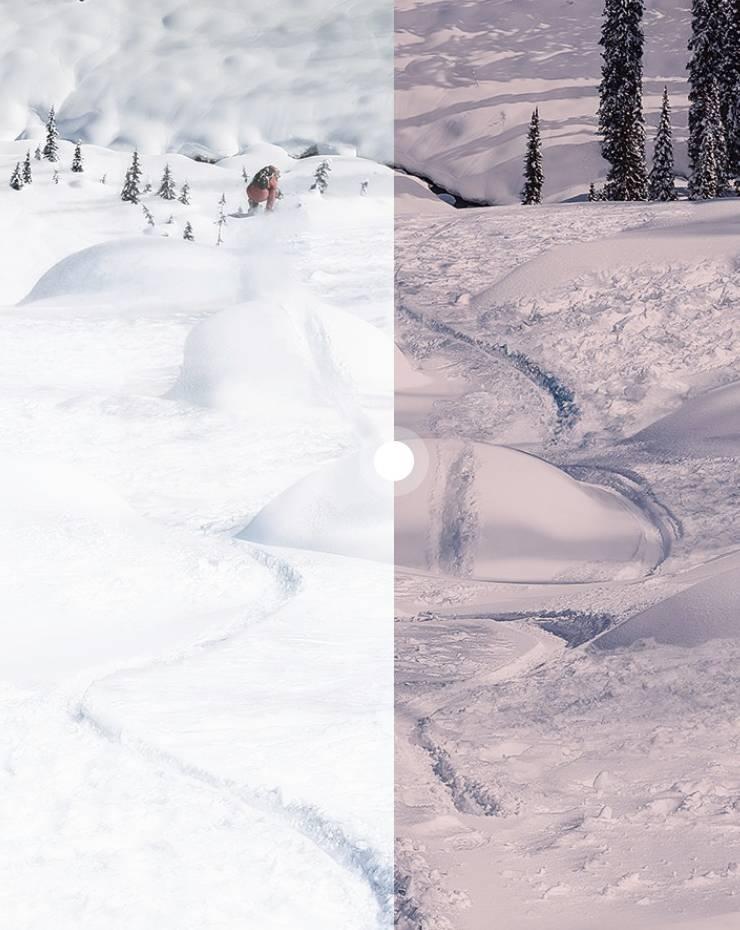
PRIZM technology on Oakley snow goggles.
How to improve the comfort of your ski goggles?
An good goggle must perform well, that’s the obvious part, but it should also be comfortable. Now that you’re on point with the different types of lenses, let’s see the other features you need to take into account.
The foam:
The inside of your goggle frame is coated with a simple, dual, or triple foam that’s directly in contact with your skin. The thickest it is, the more comfortable you’ll feel. Same idea with the shock absorption. Get yourself a quality foam to prevent skin irritations. It is important that the foam matches the shape of your face.

Dual density foam
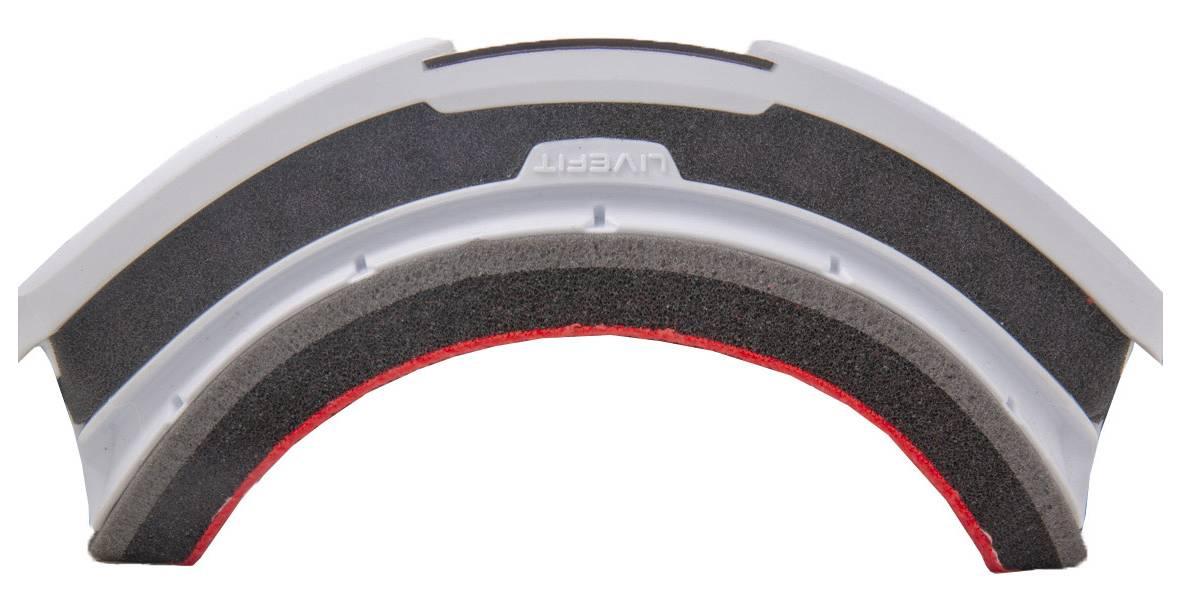
Triple density foam
The venting system:
It is crucial to prevent water condensation inside your ski goggle. A good and consistent air flow will keep the moisture away.Most brands use passive venting systems, usually located on the top, they deliver a continuous air flow you can’t adjust. But some brands also came up with more upscale venting systems, like Smith or Julbo for example.
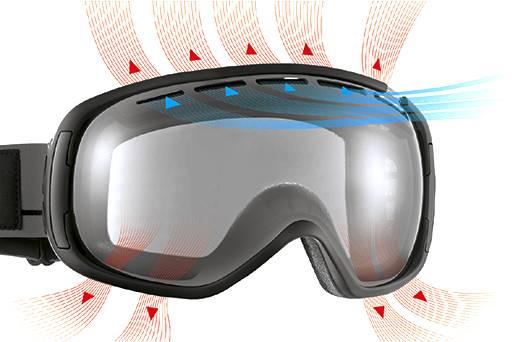
The Turbo Fan technology by Smith uses electronic micro-fans with variable speeds to enhance air flow. You can adjust the flow intensity according to the weather and your practice. This system was specifically designed for OTG goggles meaning you can use it with your prescription glasses.
The SuperFlow technology by Julbo allows for moving the lens forward to create air flow and prevent condensation. Just set your goggles on the ON position to activate the venting when you’re on the ski lifts or touring and put it back in place before hitting the slopes. You’ll find this technology on the Aerospace and Airflux models.

Discover Julbo Superflow venting system!
The anti-fog coating:
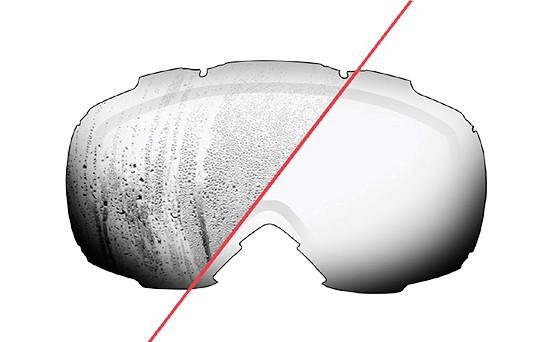
Most goggles come with an anti-fog treatment but the best protection remains the dual lens system. Two lenses are separated by a thin layer of air which works as a thermal filter between the cold air that's outside and your body warmth. This thermal shield prevents from fogging. The only downside is a more important image distortion compared to a single-lens goggles.
Tip: don’t put your goggle on your beanie or your helmet while on the lift, the difference in temperature will create fog as soon as you put them back on.
The anti-scratch treatment:
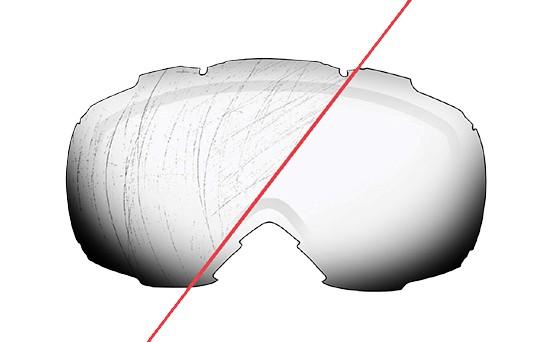
If fog can ruin a day, scratches can ruin your season and turn your goggles into something useless! Once again, most models come with an anti-scratch treatment so no worries. Some kids models even feature a bigger frame to protect the lens by reducing the potential contact surface with the ground.
Maintenance tips:
Avoid putting your ski goggles on with your gloves on! You might damage the lens. Only use a microfiber clothe to clean it up, only on the outside since you don’t want to remove the anti-fog coating on the inside. If you end up with snow on the inside, dry your goggle in open air.
Get the right size:
We are going to state the obvious but if you want top-notch comfort, your goggles need to fit your face perfectly. Sizes and shapes vary from a goggle to another, some are suited to thin faces and others are for wide faces. Make sure you know your profile before you shop!
To sum it all up, choosing a ski goggle requires a bit of work ahead. Consider your needs, your level, practice and budget. Beginners or casual riders won’t require the same gear as advanced riders. In the same way, if you’re snowboarding or freeriding, you better look for models with a wider view. If you ride only when it's sunny, you don't need a versatile lens. And when it comes to budget, think about how many times you ride a year and how quick you'll make a return on your investment.
